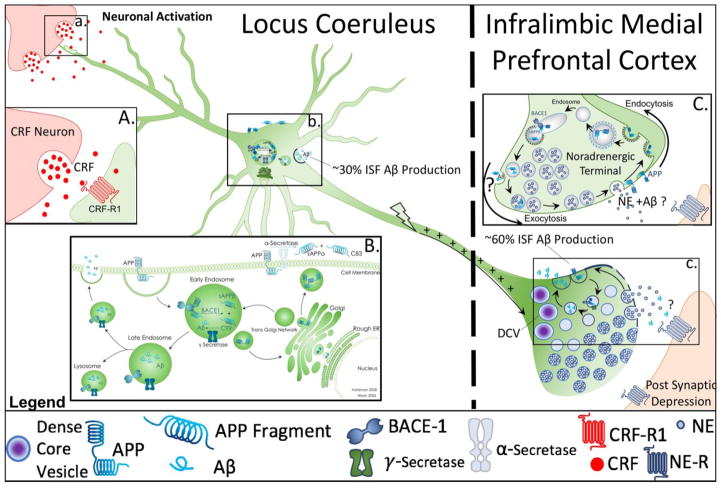Figure 1.
Cellular mechanisms of amyloid β (Aβ) production and secretion from somatodendritic and synaptic sites. This schematic reflects hypothetical and known mechanisms of Aβ production and secretion described in the literature with respect to locus coeruleus (LC)- norepinephrine (NE) circuitry. Figure 1a. points to the synaptic cleft of a corticotropin releasing factor (CRF) terminal releasing CRF onto and LC dendrite. Box 1A shows a higher magnification image of CRF release onto LC neurons under conditions of stress, engaging CRF Receptor 1, which has been implicated in Aβ production and abnormal phosphorylated tau (taup). Figure 1b. illustrates amyloid precursor protein (APP) processing within the soma of LC neurons. Box 1B. expands on the mechanistic details of APP processing within the cell body, illustrating that the subcellular localization of APP determines its participation in two divergent processing pathways: the α-secretase mediated non-amyloidogenic pathway, or the beta amyloid cleaving enzyme 1 (BACE-1) and γ-secretase mediated amyloidogenic pathway. Once Aβ is formed, it may continue along the secretory pathway, resulting in release into the extracellular space, or degradation in the lysosome (Haass, Kaether et al. 2012). Studies utilizing microdialysis have estimated that approximately 30% of endogenous interstitial fluid (ISF) Aβ is produced in the secretory pathway and released from somatodendritic processes (Box 1B), while approximately 60% is produced at the synapse (Cirrito, May et al. 2003) (Figure 1c). Box 1C illustrates that the production and secretion of Aβ at the synapse is a tightly regulated process that occurs following changes in synaptic activity, in an endocytosis dependent manner (Cirrito, Yamada et al. 2005, Cirrito, Kang et al. 2008). It has been hypothesized that increases in synaptic activity correlate with increased vesicle recycling, which leads to greater internalization of APP, and subsequent increased amyloidogenic processing (Cirrito, Kang et al. 2008). Microdialysis studies utilizing acute behavior paradigms of stress or exogenous CRF have demonstrated increased levels of ISF levels of Aβ (Kang, Cirrito et al. 2007), however, the anatomical substrates of this interaction with respect to LC neurons has not yet been investigated.

